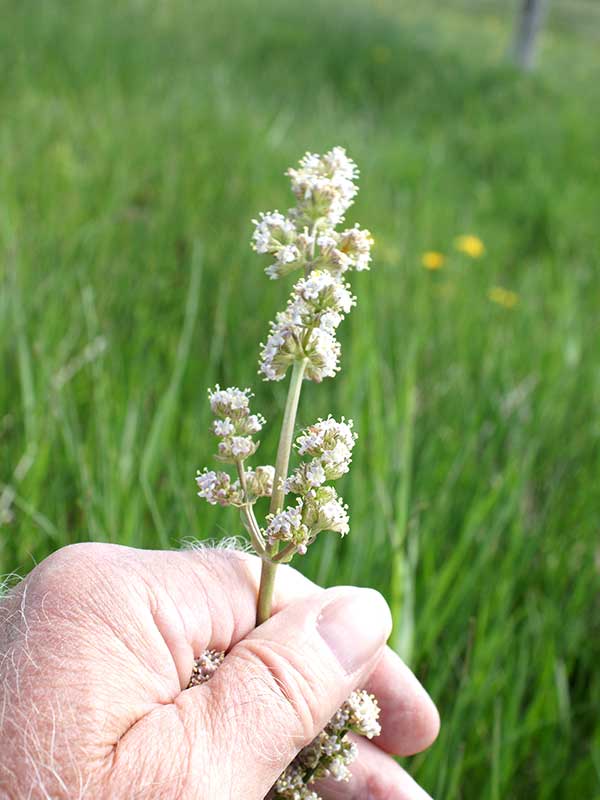Valeriana edulis / hairy valerian
- long-lived, herbaceous, dioecious perennial – limited to marshes and fens
- grass-like basal leaves; pin-like lobed, stem leaves
- teeny male flowers, white with five fused petals
- sub-millimeter female flowers
- male and female flowers usually on different plants
- overall plant stands out above wetland grasses, rushes etc.
Also known as: tobacco root, edible valerian
Hairy valerian is a herbaceous, dioecious perennial. It is amazingly long-lived, up to 300 years. It can spread by both seeds and rhizomes. Despite one of the alternate common names, it is not related to tobacco, but to the honeysuckles and elderberries. And despite the “hairy” moniker, it is only the edges of the leaves that sport small hairs.
Hairy valerian is a plant of moist prairie sites, wetlands and calcareous fens. Because it is surrounded by grasses, sedges and rushes, and because it has a large-ish white inflorescence, it is pretty visible e.g. at the end of May and beginning of June in fields down toward the river.
The inflorescences themselves are borne on elongated, sparsely leaved stems up to 4 feet tall. They are rather tall, vertical panicles with irregularly-shaped individual flower clusters on short stems widely spaced along their length, at least after the whole unit elongates.
The individual flowers are creamy white and teeny, but their size depends on their sex. Hairy valerian is dioecious (mostly) producing either staminate (male) or pistillate (female) flowers. The former are up to 1/8 inch (4 mm) across; the latter are about 0.5 mm across. Sometimes, however, just to mess things up, plants have bisexual flowers. Each male or hermaphrodite flower has 5 fused petals, spreading at first then curling back tightly. Stamens are in 3s and pistils are 3-parted at the tip.
The leaves of hairy valerian are mostly basal, up to 12 inches long and less than one inch wide. Most are entire, narrow and spatulate, but they may also be 3-lobed – as in the gallery photos. The veins are nearly parallel. The petiole is short and winged. Cauline leaves, i.e. those up the flowering stalk, are shorter and finely, pinnately divided.
Interesting bits – Despite the large swards that are found in parts of the Valley, hairy valerian is considered threatened, mostly because of habitat destruction. Besides the need for moist soils, its requirement of a fairly high soil pH further limits its habitat options. Fortunately for us, the Valley bottom is fen and the Tetons provide a continued source of high pH water.
As the Latin name suggests, the hairy valerian is edible, except for the fact that the part one eats is the carrot-like taproot, and it, alas, is highly poisonous – if eaten raw. The cooking protocol is rather extensive steaming for 24 hours or baking in the ground for two days. This detoxifies the toxins and also removes most of the sweaty-sock smell. If your mother says you can try it, the roots are best when collected in fall or spring, when firm. After steaming or baking in the ground, the result can either used in soup or ground into flour.
An oft-quoted discussion of this plant’s edibility asset is attributed to the explorer John Charles Frémont from the 1840s. He noted that edible valerian was a principle food of the indigenous peoples on the western side of the mountains where he was wandering. He said, “It has a very strong and remarkably peculiar taste and odor… which to some persons is extremely offensive.” One of his companions characterized it as “the most horrid food he had ever put in his mouth.” To others, however, “the taste is rather an agreeable one, and I was afterwards always glad when it formed an addition to our scanty meals. It is full of nutriment.”
As might also be expected for a highly toxic plant, valerian roots have also been used medicinally, the medically active compound being valerianic acid. This is the smelly stuff, apparently, but is also said to have a catnip effect on cats. As a medicine, it has been especially used for insomnia and to treat various central nervous system disorders. The list of side effects is non-trivial. For this one, your mom won’t be of help, unless she is also a doctor.
| Color | |
|---|---|
| Family | |
| Blossom size | |
| Inflorescence size | |
| Inflorescence type | |
| When? | |
| Where? |




